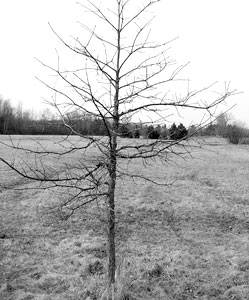 |
| Wood from white oak (shown here), black locust, cedar and honey locust can be used as an organic alternative to pressure-treated wood. English photo. |
By Eric Sideman, Ph.D.
I have worked for MOFGA for nearly 20 years as the “answer man,” and questions about treated lumber have come in every spring when gardeners and farmers start building projects or replacing fence posts. The names of the synthetic materials used to treat wood to deter insects and fungi do not sound organic and raise eyebrows of even moderately aware consumers standing at the shelf reading the label. So they call me to see if treated wood is safe.
Twenty years ago those of us who had concerns were up against the store owners and manufacturers who swore the materials were safe. Today the EPA has made the decision easier for us since it changed the category of the most common wood treatment of the past (CCA) to a restricted-use pesticide and has said that CCA-treated wood will no longer be allowed, even in residential uses, after December 2003. Newer and safer materials exist for those who can turn to synthetics, but for certified organic growers, only naturally preserved wood is allowed. Read on if you would like more information about the regulations.
The most common wood treatment, as I mentioned, is CCA, or chromated copper arsenate. This is often referred to as “pressure treated lumber,” because it is made by dissolving compounds of chromium, copper and arsenic in ammonia and forcing them deep into the wood using high pressure. Recent studies show that the arsenic can be absorbed through skin in contact with the wood, and all three materials have been shown to leach from the wood and get into soil.
Other wood treatments include creosote (a restricted use pesticide made from coal tar that can volatilize into the air) and pentachlorophenol (which may contain dioxins). These are usually used for railroad ties or telephone poles and should never be used anywhere indoors or near food production.
A number of other new and safer synthetic wood treatments are less risky to the environment or human health. These include ammoniacal copper citrate (CC), copper azole (CBA) and alkaline copper quaternary (ACQ). But, since these are synthetic treatments that have not been reviewed by the National Organic Standards Board (NOSB) and listed by the National Organic Program (NOP), they are not permitted for new installations or replacement purposes in contact with soil or livestock used for organic production. (See Section 205.206(f) of the National Organic Program Rule.)
Boric acid is an alternative wood treatment for insect control that can be bought and applied to lumber by the user. Borate-treated lumber is also available. Boric acid is also a synthetic material but is listed in the NOP Rule as a permitted synthetic material. [See Section 205.601 (e)(2).] Use of borate-treated wood is restricted by the Rule to structural pest control, and the wood is not allowed in contact with crops. Even if you are not concerned with the NOP Rule, you should not use borate-treated wood in the garden, because borates are water soluble and will leach from the wood that is in contact with water in the soil. (Although boron is an essential plant nutrient, it is needed in very small concentrations and is toxic to plants in greater concentrations.) Borate-treated wood is not suitable for outdoor use or for any place that is in contact with soil. Borate-treated lumber should be used only in locations that are at least 6 inches above the ground and protected from excessive rain.
(For a list of sources of borate products see Quarles, 2002.)
Native Wood
I believe that the least environmental impact would come from using native wood that is naturally resistant to decay and insects. Native wood does not have the lifespan of CCA pressure treated wood but can last 10 to 20 years, depending on the species available and the site. Wet, warm soil promotes quicker decay.
The proportion of heartwood to sapwood also plays a role in how long a fence post can last. Heartwood is the dark, old wood in the center of a tree; it is dense and conducts little water in the living tree. This is the characteristic that makes these species more decay resistant. Sapwood is the light colored wood between the bark and the heartwood. It is the wood that actively conducts water in the living tree and is very porous in a dead log or fence post. Consequently, it absorbs water and decays faster than heartwood. The best fence posts are those with the least sapwood.
The species of tree is the most important factor in the resistance to decay. Black locust will last longer than any other fence post around here. Cedars, honey locust and white oak will last 10 to 15 years. You may get five years out of white pine posts. Trees such as beech, poplar, red oak and hemlock will topple over before they’re in the ground for five years.
Further Resources
Gregner, Lance. 2002. Organic Alternatives to Treated Lumber. www.attra.ncat.org or call 1-800-346-9140.
Quarles, William. 2002. Alternatives to arsenic-treated wood. Common Sense Pest Control, Winter. p. 13-22.
About the author: Eric is MOFGA’s director of technical services. You can contact him with your questions at [email protected] or at 946-4402.
